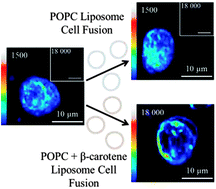Carotenoid based bio-compatible labels for third harmonic generation microscopy†
Abstract
The use of carotenoids as biologically friendly labels for third harmonic generation (THG) microscopy is demonstrated. Carotenoid containing liposomes are used to label cell structures via liposome cell fusion. The THG microscopy labels, called harmonophores, were characterized by measuring the third-order nonlinear susceptibility (χ(3)) of carotenoids: violaxanthin, neoxanthin, lutein, β-carotene, zeaxanthin, canthaxanthin and astaxanthin. The THG ratio method was used, which is based on measuring the THG intensity from two interfaces using a nonlinear optical microscope. The second hyperpolarizability values of carotenoids were extracted from χ(3) measurements taking into account the refractive index at fundamental and third harmonic wavelengths. The length dependence of the second hyperpolarizability of conjugated polyenes from 9 to 13 double bonds with varying oxygen functional groups was investigated. It appears that the presence of epoxides can have a higher influence than an additional conjugated double bond. Furthermore, labelling of both Drosophila Schneider 2 cells and Drosophila melanogaster larvae myocytes with β-carotene was achieved. This study demonstrates that THG enhancement by carotenoids can be used for nontoxic in vivo labelling of subcellular structures for third harmonic generation microscopy.


 Please wait while we load your content...
Please wait while we load your content...